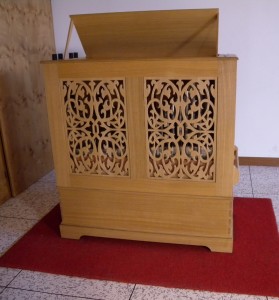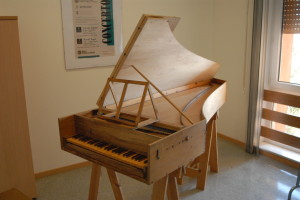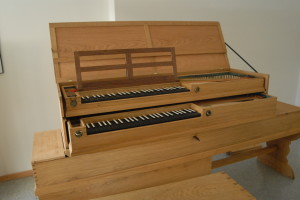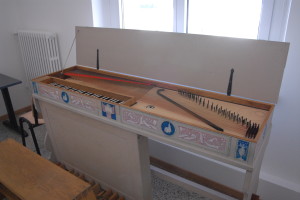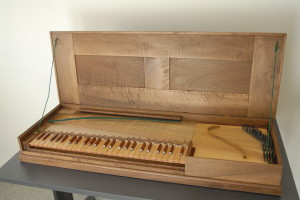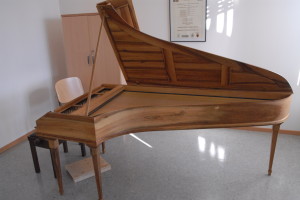Our instruments
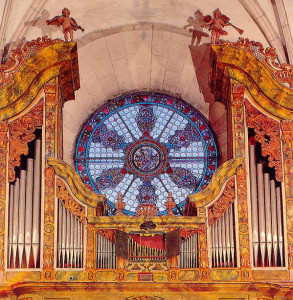
One manual – Italian 14 key pedal.
Stop disposition is the following:
PRINCIPAL BASSO VOCE UMANA
PRINCIPAL / SOPRANO CORNETO / PRIMO
OTTAVA CORNETA
QUINTA / DECIMA FLAUTO OTTA/VA BASSO
DECIMA / NONA FLAUTO OTTA/VA SOPRANO
VIGESIMA / SECONDA FLAUTO IN / QUINTA
VIGESIMA / SESTA FLAUSOLE’
VIGESIMA / NONA TROMBE / PEDALI
TRIGESIMA / TERZA CONTRO BASSI
TRIGESIMA / SESTA OTTAVE DE / CONTROBASSI
In the Santi Martiri Anauniensi parish curch, in Sanzeno (TN), an important organ is conserved. It was built by Innocenzo Cavazzani, from Avio (TN), in 1792. The instrument was inserted in a pre-existing case, built by Giuseppe Waiz in 1759. The works we still have today by the Avio organ-builder are the instrument in Pesina (VR) dated to 1791 and a conspicious amount of pipes reused in the Vegezzi Bossi organ, dated to 1911, in Pilcante (TN). The recently concluded restoration allowed to completely recover the instrument and to collect much information about the building features and Innocenzo Cavazzani’s operating choices. The restoring operations necessarily had to consider the intervention by Alfredo Piccinelli in 1972, which was not always conducted in the best way. At that time, some restoration practices even if considered very advanced, were in fact not very respectful of the ancient material and when possible, they have now been fixed. During the restoration, the instrument was deeply analysed, in order to get each little detail, to better understand the builder him-self and the necessary interventions. The phonic material was worth considering. In fact, it was made an inventory (before and after the restoration) and detailed surveys. The comparison with some other workshops (contemporary to Cavazzani’s) allowed to underline significant differences from what was used at that time, because he was following a different artistic path. The unique signatures Cavazzani used were intensely analysed and photographed. He used to follow someway the veronese-gardesana-desenzanese school, but he never truly adopt its rules. In order to get useful information for other restorations, there was a survey on the harmonics of some pipes (chosen during a preliminary inspection), both before and after the restoration, in favour of getting each little change due to the intervention. Even the very complex case was fully reported with a numeric survey (by mean of a laser instrument) and not just by the simple photographic report. Considering the peculiarity of this instrument and its original features, the restoration was not easy (also because there were two types of register never seen before), but at the same time, it was worth it thanks to its charm. In fact, it deserved its own “report”.www.serassi.it

Built for the Concert hall of the Smarano Academy, the organ has been made according to the style and mechanics of the the Renaissance historical instruments, with specific reference to the Antegnati tradition and, in general, of the contemporary instruments of the northern side of Italy; this both in terms of voicing, mechanics and construction styles.
Manual:
Principale (95% of tin) (8’, front pipes from Fa1 are 6’)
Ottava
Quintadecima
Decimanona (rit. Fa#4)
Vigesimaseconda (rit. Do#4)
Vigesimasesta (rit. Fa#3, Fa#4)
Vigesimanona (rit. Do#3, Do#4)
Flauto in Ottava
Flauto in Duodecima
Cornetta
Fiffaro (from Do#2)
Regale bassi
Regale soprani
Split bassi/soprani: ( Do3/Do#3)
Keyboard: 45 key (Do1-Do5) short octave,split keys (tasti enarmonici) for Mib2,3,4 e Sol#2,3
Pedal: 14 keys (Do1-Fa2) linked to manual keyboard.
Temperament: Meantone
Pitch: 440 Hz
Wind presure: 38 mm H2O
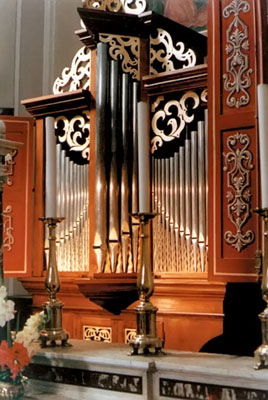
The instrument of S. Maria Assunta church in Smarano was built by the Organ builder Glauco Ghilardi from Lucca (Tuscany) in 1992.The organ is inspired by the Flemish models of XVI century in its phonetic and technical features.
The organ maker says: “Even though it isn’t a copy, the attempted operation is to synthesize, with stylistic rigor and personal creativity, elements and stimula derived from studies on an historical instrument and from playing experiences of literature from that period”. When the both appealing and disappointing hypothesis of an “omnibus” organ (suitable for all types of literature) was discarded, the organ builder thought at an instrument “aiming to Flemish and Northern German Literature of XVI and XVII centuries”, from the assumption that “a strongly characterized instrument doesn’t prevent from playing literatures that are different from the ones for which it was conceived”.
Features
Two Manuals. 51 keys (Do1-Re5)
Pedal. 27 keys (Do1-Re3)
Pressure 65 mm H2O
Diapason 440
Kellner Temperament
All pipes are 95% lead alloy made, except for Regale tubas, which are 70% tin alloy made.
Grand’organo (Manual I)
Principale 8 (P8)
Ottava 4 (O4)
Decimaseconda 2 2/3 bassi/soprani (D22/3)
Decimaquinta 2 (D2)
Terza 1 3/5 bassi/soprani (T11/35)
Decimanona 1 1/3 (D11/3)
Pieno a 3 file (PIII)
Flauto a cuspide 8 (F8)
Dulzian 8′
Positivo (Brust, manual II)
Vox Humana 8
Flauto a camino 4 (F4)
Flauto conico 2 (F2)
Quinta 1 1/3 (Q11/3)
Terza 3/5 (T3/5)
Pedale
Subbasso 16 (S16)
Flauto a cupide 8 [from O.W.] (F8)
Corno 4 (C4)
Trombone 16 (T16)
Couplers: II/I [played from II]; I/Ped; II/Ped
Tremolo
Usignolo
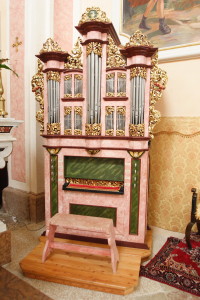
A positive Organ has been designed by Edoardo Bellotti and. Hans Davidsson and built by Janis Kalnins, from Latvia.
The instrument has been built acording to the baroque organ building tradition of the Baltic area g as copy of the historic 1701 organ in Ugale (Latvia) with some technical modification.
Features
Keyboard C – d³, cromatic.
Transposer from 415 – 440 – 465 Hz
Gedackt 8′ wood
Blockflojt 4′ wood,open
Nasard 3′ wood,open
Principal 2′ meantone
Principal 2′ (equabile)
Zincke 8′ , (reed)
Bird song…
Metal pipes are 60% tin and 40% led , wooden pipes are pine.
Pressure 72mm
Electric and manual bellows
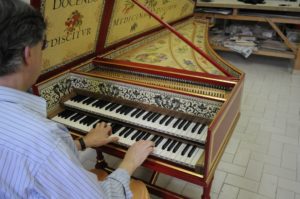 Features:
Features:
2 manuals
4 stop
Transposer
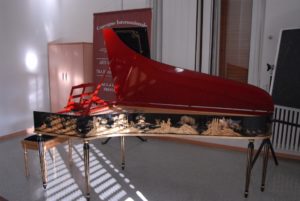 Features:
Features:
2 manuals
4 stop
Transposer 440/415 Hz
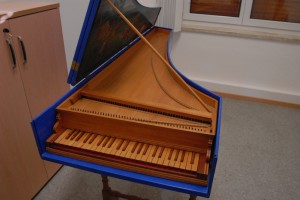 Feautures:
Feautures:
2 stop
Transposer
These instruments, except the Ghilardi and the Cimmino organs, are being located in the School in 12 new practising rooms.

